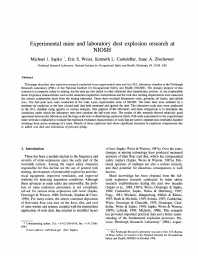Mining Publication: Experimental Mine and Laboratory Dust Explosion Research at NIOSH
Original creation date: May 2000
This paper describes dust explosion research conducted in an experimental mine and in a 20-L laboratory chamber at the Pittsburgh Research Laboratory (PRL) of the National Institute for Occupational Safety and Health (NIOSH). The primary purpose of this research is to improve safety in mining, but the data are also useful to other industries that manufacture, process, or use combustible dusts. Explosion characteristics such as the minimum explosible concentration and the rock dust inerting requirements were measured for various combustible dusts from the mining industries. These dusts included bituminous coals, gilsonite, oil shales, and sulfide ores. These full-scale tests were conducted at the Lake Lynn experimental mine of NIOSH. The mine tests were initiated by a methane-air explosion at the face (closed end) that both entrained and ignited the dust. The laboratory-scale tests were conducted in the 20-L chamber using ignitors of various energies. One purpose of the laboratory and mine comparison is to determine the conditions under which the laboratory tests best simulate the full-scale tests. The results of this research showed relatively good agreement between the laboratory and large-scale tests in determining explosion limits. Full-scale experiments in the experimental mine were also conducted to evaluate the explosion resistance characteristics of seals that are used to separate non-ventilated, inactive workings from active workings in a mine. Results of these explosion tests show significant increases in explosion overpressure due to added coal dust and indications of pressure piling.
Authors: MJ Sapko, ES Weiss, KL Cashdollar, IA Zlochower
Peer Reviewed Journal Article - May 2000
NIOSHTIC2 Number: 20022707
J Loss Prev Process Ind 2000 May; 13(3) :229-242
See Also
- Compendium of Structural Testing Data for 20-psi Coal Mine Seals
- Determining the Root Causes of Flame Cutting and Welding Fires in Underground U.S. Coal Mines
- Evaluation of Mine Seals Using Ground Penetrating Radar
- The Explosibility of Coal Dust
- Explosion Pressure Design Criteria for New Seals in U.S. Coal Mines
- Explosion Temperatures and Pressures of Metals and Other Elemental Dust Clouds
- Progress Toward Improved Engineering of Seals and Sealed Areas of Coal Mines
- Rapid (Grab) Sampling During Full-scale Explosions - Microscopic and Analytical Evaluation
- Structural Analysis and Design of Seals for Coal Mine Safety
- Use of Ground Penetrating Radar and Schmidt Hammer Tests to Determine the Structural Integrity of a Mine Seal
- Content source: National Institute for Occupational Safety and Health, Mining Program


 ShareCompartir
ShareCompartir
